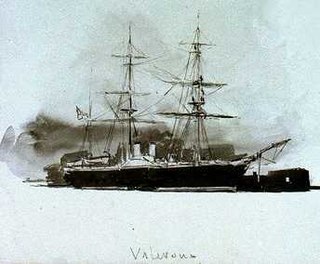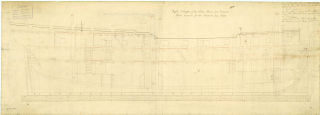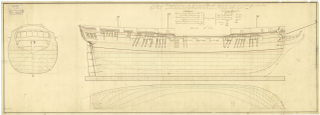Related Research Articles

HMS Lowestoffe was a 28-gun Lowestoffe-class sixth-rate frigate of the Royal Navy. Named after the UK's most easterly port of Lowestoft in Suffolk the ship was designed by Sir Thomas Slade based on the earlier Lyme of 1748, "with such alterations as may tend to the better stowing of men and carrying for guns." The design provided for a 24-gun ship of 583 tons, but on completion the ship measured some 11 tons more.

HMS Argo was a 28-gun sixth-rate frigate of the Royal Navy. The ship was one of the Coventry class, designed by Sir Thomas Slade as a development of based on HMS Lyme, "with such alterations as may tend to the better stowing of men and carrying for guns."
The Lowestoffe class were a class of two 28-gun sixth-rate frigates of the Royal Navy. They served during the Seven Years' War, with HMS Tartar surviving to see action in the American War of Independence and the French Revolutionary Wars.

HMS Coventry was a 28-gun sixth-rate frigate of the Royal Navy, launched in 1757 and in active service as a privateer hunter during the Seven Years' War, and as part of the British fleet in India during the Anglo-French War. After seventeen years' in British service she was captured by the French in 1783, off Ganjam in the Bay of Bengal. Thereafter she spent two years as part of the French Navy until January 1785 when she was removed from service at the port of Brest. She was broken up in 1786.

The Dublin-class ships of the line were a class of seven 74-gun third rates, designed for the Royal Navy by Sir Thomas Slade.

HMS Valorous was one of two 16-gun, steam-powered Magicienne-class second-class paddle frigates built for the Royal Navy in the 1850s. Commissioned in 1853 she played a small role in the Crimean War of 1854–1855 and was sold for scrap in 1891.
The Southampton-class frigates were 32-gun sailing frigates of the fifth rate produced for the Royal Navy. They were designed in 1756 by Sir Thomas Slade, and were the first 'true' fifth-rate frigates produced to the new single-deck concept. They were, however, designed with sweep ports along the lower deck.
The Richmond-class frigates were 32-gun sailing frigates of the fifth rate produced for the Royal Navy. They were designed in 1756 by the Navy's Surveyor, William Bately, and were his equivalent of the Southampton-class frigates designed by Bately's co-Surveyor, Thomas Slade. They were faster ships than the Southamptons, and were weatherly craft, remaining dry even in high seas. Three ships were ordered to this design between 1756 and 1757, while a second batch of three ships was ordered between 1761 and 1762 to a slightly modified design.
The Niger-class frigates were 32-gun sailing frigates of the fifth rate produced for the Royal Navy. They were designed in 1757 by Sir Thomas Slade, and were an improvement on his 1756 design for the 32-gun Southampton-class frigates.

HMS Venus was the name ship of the 36-gun Venus-class fifth-rate frigates of the Royal Navy. She was launched in 1758 and served for more than half a century until 1809. She was reduced from 36 to 32 guns in 1792. She was sold in 1822.

HMS Pallas was one of the three 36-gun Venus-class fifth-rate frigates of the Royal Navy. She was launched in 1757 and initially served in Sir Edward Hawke's fleet blockading the coast of France where she fought at the Raid on Cherbourg and in the Battle of Bishops Court. She later served for a number of years in the Mediterranean Sea before moving to serve off the coast of Africa between 1774 and 1776 where she protected the isolated British colonies. In 1778 she joined the Newfoundland Station and participated in the attack on Saint Pierre and Miquelon. Pallas returned to the English Channel after this and assisted in destroying a French invasion force intended for the Channel Islands in 1779 before briefly serving on the Jamaica Station. In 1783 she was beached on São Jorge Island after she was found to be heavily leaking; she was burned there on 24 February.

HMS Brilliant was a 36-gun Venus-class fifth-rate frigate of the British Royal Navy that saw active service during the Seven Years' War with France. She performed well against the French Navy in the 1760 Battle of Bishops Court and the 1761 Battle of Cape Finisterre, but was less capable when deployed for bombardment duty off enemy ports. She also captured eight French privateers and sank two more during her six years at sea. The Royal Navy decommissioned Brilliant in 1763. The Navy sold her in 1776 and she became an East Indiaman for the British East India Company (EIC). Brilliant was wrecked in August 1782 on the Comoro Islands while transporting troops to India.

HMS Actaeon was a 28-gun Coventry-class sixth-rate frigate of the Royal Navy. Her crewing complement was 200 and, when fully equipped, she was armed with 24 nine-pounder cannons, supported by four three-pounders and twelve 1⁄2-pounder swivel guns.

HMS Griffin was a 28-gun Coventry-class sixth-rate frigate of the Royal Navy.

HMS Magicienne was the lead ship of her class of two 16-gun, steam-powered second-class paddle frigates built for the Royal Navy in the 1850s. Commissioned in 1853 she played a small role in the Crimean War of 1854–1855 and was sold for scrap in 1866.

The Albacore-class gunboat, also known as "Crimean gunboat", was a class of 98 gunboats built for the Royal Navy in 1855 and 1856 for use in the 1853-1856 Crimean War. The design of the class, by W. H. Walker, was approved on 18 April 1855. The first vessels were ordered the same day, and 48 were on order by July; a second batch, which included Surly, were ordered in early October.

The Thames-class frigate was a 32-gun fifth-rate frigate class of eight ships of the Royal Navy based on the Richmond-class frigate designed by William Bately. The ships were ordered to the older design, which was of a smaller type of ship compared to more modern designs, so that they could be built quickly and cheaply in time to assist in defending against Napoleon's expected invasion of Britain. The class received several design changes to the Richmond class, being built of fir instead of oak, with these changes making the class generally slower and less weatherly than their predecessors, especially when in heavy weather conditions. The first two ships of the class, Pallas and Circe, were ordered on 16 March 1804 with two more ordered on 1 May and the final four on 12 July. The final ship of the class, Medea, was cancelled on 22 October before construction could begin but the other seven ships of the class were commissioned between 1804 and 1806.

HMS Jason was a 36-gun fifth-rate Penelope-class frigate, launched in 1800. She served the entirety of her career in the English Channel, mostly in the frigate squadron of Commodore Charles Cunningham. Serving off the coast of France, especially around Le Havre and Cherbourg, she captured several French privateers and recaptured a British merchant ship in a cutting out expedition. Having only been in commission for around fifteen months, Jason was wrecked off the coast of St Malo on 21 July 1801. Her crew were saved and later exchanged, and in August her wreck was burned to prevent the French from rescuing it.

The Perseverance-class frigate was a 36-gun, later 42-gun, 18-pounder fifth-rate frigate class of twelve ships of the Royal Navy, constructed in two batches. Designed by Surveyor of the Navy Sir Edward Hunt the first iteration, consisting of four ships, was constructed as a rival to the similar Flora-class frigate. Strongly built ships, the Perseverance class provided favourable gunnery characteristics and was highly manoeuvrable, but bought these traits with a loss of speed. The name ship of the class, Perseverance, was ordered in 1779 and participated in the American Revolutionary War, but her three sister ships were constructed too late to take part. The class continued in service after the war, but soon became outdated.
References
Bibliography
- Gardner, Robert (1992). The First Frigates: Nine-Pounder and Twelve-Pounder Frigates, 1748-1815. Conway Maritime Press. ISBN 0851776019.
- Winfield, Rif (2007). British Warships of the Age of Sail 1714–1792: Design, Construction, Careers and Fates. Seaforth. ISBN 9781844157006.